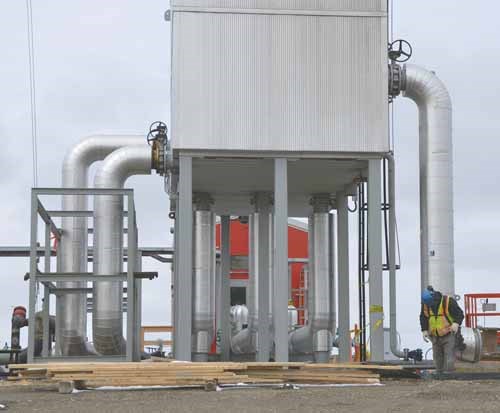Synchronizing ore cutting, hoisting with an expanded milling capacity Mosaic Esterhazy, May 15, 2012 - The expansion project that began in 2008 at The Mosaic Company's Esterhazy K1 and K2 sites is coming to a close. Esterhazy's K2 underground operation will soon be fully-synchronized with the expanded milling capacity on surface.
With the additional milling capacity at K2, the Mill can now process every ore ton that the K2 hoist can deliver. The underground expansion project includes the construction of remote storage bins in the K2 Mine, to streamline the flow of ore to the mill, and two new four-rotor miners. One of the new miners 'trammed' its way out of the new K2 four-rotor assembly shop last week and the second one is scheduled to follow mid-October.
The K2 remote storage area will provide a constant ore supply to maximize hoisting time.
The remote storage bins are scheduled to be commissioned in 2012. The new miners will help ensure that there is enough ore in the storage bins to keep the conveyors loaded 24 hours per day..
Previously, all miners were assembled underground at K1. However, the travel time from the K1 assembly shop to the areas that are currently being mined at K2 - an area that is described as "somewhere east of Carlton Trail Regional Park and a bit south" - is prohibitive.
K3: Focus inward, upward
Mosaic Esterhazy, May 15, 2012 - A year's work excavating, drilling, and pouring concrete is disappearing out-of-sight as contractors gradually backfill the foundations of the two shafts at The Mosaic Company's K3 potash mine site. Attention is now being turned inward and upward simultaneously.
The K3 project, approximately four kilometres east of Esterhazy, reached a recent milestone when five units of the freeze plant were powered-up, marking the beginning of the slow gradual process of freezing the ground to a depth of 1,600 feet in preparation for the sinking of the service shaft. The full freeze plant will be in operation in the near future to freeze the production shaft and will remain in operation for approximately two years. It will be shutdown when the shaft excavation has been completed through the Blairmore formation.
A second milestone was marked last week when the service shaft foundation reached grade. Motorists passing the K3 site on Highway No. 22 will soon see both the service and the production shafts rising steadily above the horizon.
The service shaft headframe will rise to a height of 374 feet. When completed, it will be the tallest structure between Calgary and Winnipeg. The slip-form construction will see the service shaft headframe rise above grade at an estimated rate of 11 inches per hour, as concrete will pour continuously, 24 hours a day, seven days a week until completion. The service shaft headframe will house what is expected to be the world's largest Koepe hoist.
The production shaft will have a temporary steel headframe designed only for shaft-sinking then egress, at this point in time.
The pre-sink phase of shaft sinking is expected to begin in the coming months, making way for a multi-layered work platform called a galloway to be lowered into the shaft. This galloway will be used to complete the approximate 3,400 feet of shaft sinking.



